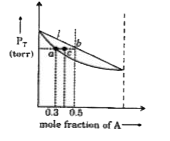F centre is an example of metal excess defect due to the presence of extra cations at interstitial sites. Zinc oxide is white in colour at room temperature, on heating it loses oxygen and turns yellow.
ZnOHeat−−→Zn2++12O2+2e−
Now there is excess of zinc in the crystal and its formula becomes Zn1+x O. the excess of Zn2+ ions move to interstitial sites and the electrons to neighbouring interstitial sites.
There are many solids which are difficult to prepare in the stiochiometric composition and contain less amount of the metal as compared to stiochiometric proportion. a typical example of this type is FeO which is mostly found with a composition of Fe0.95. it may actually range from Fe0.96 O.
Q. In Fe0.95 O:Solution in Malayalam
Metal excess defect is present
Metal deficiency defect is present
F-centre is present
All of the above are present
The correct Answer is:B
Metal deficiency defect is present
Topper's Solved these Questions
- BOOK - BRILLIANT PUBLICATIONCHAPTER - SOLID STATEEXERCISE - LEVEL-3 (Statement Type)5videos
SOLID STATE
- BOOK - BRILLIANT PUBLICATIONCHAPTER - REDOX REACTION & ELECTROCHEMISTRYEXERCISE - QUESTION (ELECTROCHEMISTRY) (LEVEL -II) (ASSERTION-REASON)3videos
REDOX REACTION & ELECTROCHEMISTRY
- BOOK - BRILLIANT PUBLICATIONCHAPTER - SOLUTIONSEXERCISE - Level-III (Linked Comprehension Type)12videos
SOLUTIONS
Similar Questions
Statement 1: In crystal lattice, the size of the tetrahedral void is larger than an octahedral void.
Statement 2: The cations occupy less space than anions in crystal packing.03:53View SolutionAssertion: After the electrolysis of aqueous CuSO4 solution pH decreases.
Reason: Sulphuric acid is formed.02:50View Solution1 mole of A and 1 mole B are mixed together to form an ideal solution at 25∘C. Solution is placed in a vessel fitted with piston. If pressure on the solution is reduced isothermally.

Correct relationship between P∘AandP∘B is01:37View SolutionAssertion (A) : Non-stoichiometric compounds are called Bertholide compounds. NaCl and KCl crystal, when heated in an atmosphere of Na and K varpours, respectively, they impart violet and yellow colours to NaCl and KCl , respectively. Reason (R ) : Metal excess defect is due to the presence of extra cations atg the interstitial sites. The excess metal ions move to the interstitial sites and the electrons to the neighbouring sites. The colour results byt the excitation of these electrons by absorbing suitable energy from visible light. When the excited electroon comes back to the ground state, there is emission of radiation in the visible region and gives complimentary colour.
View SolutionWhich type of defect has the presence of cations in the interstitial sites ?
08:17View SolutionWhich type of 'defect' has the pressence of cations in the interstitial sites?
View SolutionZince oxide loses oxygen on heating accroding to the reaction ZnOoverset("heat") to Zn^(2+)(1)/(2)O_(2)+2e^(-) It becomes yellow heating because
View SolutionWhich type of defect has the presence of cations in the interstitial sites-
03:09View SolutionWhich type pf 'defect has the presence of cations in the interstitial sites ?
02:50View SolutionAssertion (A) : Zinc oxide is colourless at room temperature but on heating it becomes yellow in colour.
Reason (R) : On heating Zinc loses oxygen and thereby forming free Zn2+ ions. The excess Zn2+ ions move to interstitial sites and the electrons also occupy interstitial positions.03:45View SolutionAssertion : In ZnO, the excess Zn^(2+) ions are present in interstitial sites. Reason : Metal excess crystals have either missing cation or anion in interstitial site.
02:43View SolutionWhich type of defect has the presence of cations in the interstitial sites ?
03:40View Solutionअभिक्रिया के अनुसार, गर्म किए जाने पर जिंक ऑक्साइड ऑक्सीजन को खोता है-
ZnOheat−−→Zn2++12O2+2e−
गर्म किए जाने पर यह पीला बनता है क्योंकि44:44View Solution(A) Zinc oxide is yellow coloured when hot (R) Zinc oxide has metal excess defect due to anionic vacancies
View SolutionStoichiometric defects are of two types such as vacancy defects and interstitial defects. )On heating white ZnO it turns yellow. Which is the crystal involved here? Explain.
53:09View SolutionImpurity Defect Questions|Non-Stoichiometric Defect|Questions|Metal Excess Defect Due To The Presence Of Extra Cations At Interstitial Sites|Summary
01:34:10View Solution

